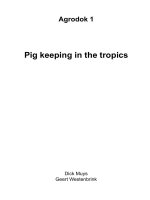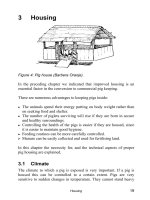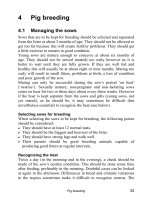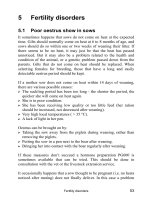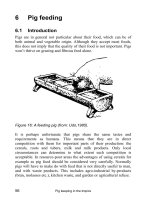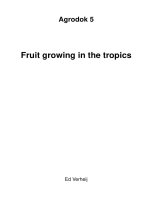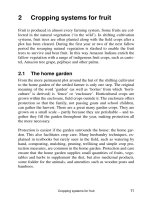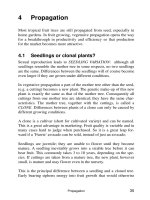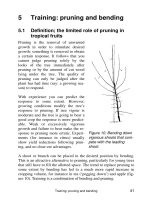Fruit growing in the tropics - Part 2 ppsx
Bạn đang xem bản rút gọn của tài liệu. Xem và tải ngay bản đầy đủ của tài liệu tại đây (17.04 KB, 4 trang )
Cropping systems for fruit
11
2 Cropping systems for fruit
Fruit is produced in almost every farming system. Some fruits are col-
lected in the natural vegetation (‘in the wild’). In shifting cultivation
systems, fruit trees are often planted along with the field crops after a
plot has been cleared. During the first year or two of the next fallow
period the resurging natural vegetation is slashed to enable the fruit
trees to survive and bear fruit. In this way Amazon Indians enrich the
fallow vegetation with a range of indigenous fruit crops, such as canis-
tel, Amazon tree grape, pejibaye and other palms.
2.1 The home garden
From the more permanent plot around the hut of the shifting cultivator
to the home garden of the settled farmer is only one step. The original
meaning of the word ‘garden’ (as well as ‘hortus’ from which ‘horti-
culture’ is derived) is ‘fence’ or ‘enclosure’. Horticultural crops are
grown within the enclosure, field crops outside it. The enclosure offers
protection so that the family, not passing goats and school children,
can gather the harvest. There are a great many garden crops. They are
grown on a small scale – partly because they are perishable – and to-
gether they fill the garden throughout the year, making protection all
the more necessary.
Protection is easiest if the garden surrounds the house: the home gar-
den. This also facilitates crop care. Many husbandry techniques, ex-
plained in textbooks but rarely seen in the field, such as watering by
hand, composting, mulching, pruning, trellising and simple crop pro-
tection measures, are common in the home garden. Protection and care
ensure that the home garden supplies small quantities of fruits, vege-
tables and herbs to supplement the diet, but also medicinal products,
some fodder for the animals, and amenities such as wooden posts and
bamboos.
Fruit growing in the tropics
12
2.2 Orchards and plantations
Near the growing towns some home gardens developed into market
gardens and further specialisation led to new professions: vegetable
grower, fruit grower, nurseryman, etc., all producing primarily for the
market.
However, of the many different fruit crops in home gardens only a few
are found in orchards producing for the market. The reason is both
simple and shocking: fruit growers cannot grow these crops profitably,
because they produce too little and/or too erratically, and it takes too
many years bvefore they bear fruit! Why plant an orchard of durians if
you have to wait up to 10 years for the trees to produce a worthwhile
crop? And look at the mango trees in your area: people notice a single
tree full of fruit, but tend to overlook 10 others that hardly bear any
fruit. In fact the mango, one of the most important fruit crops, bears so
erratically that it is difficult to estimate what a “normal” yield is. On
the other hand, pineapple and banana are so productive that investors
are prepared to finance large-scale plantations of these fruits. This is
shown in figure 1 where home gardening is compared with the more
commercial cropping systems.
Figure 1: Cropping system, crops and yield levels. All cultivated
fruit crops are grown in home gardens, but only those that bear
good crops are found in more commercial cropping systems.
Cropping systems for fruit
13
Some fruits are only found growing in the wild; all cultivated fruits
are grown in home gardens, but only a few have made it as orchard or
plantation crops. Looking more closely at figure 1 it is clear that the
crops suited to production in orchards or plantations are not only high-
yielding; they also need only a short period from planting to full pro-
duction, and they remain small. Pineapple and banana, the 2 plantation
crops, show these properties in the extreme.
2.3 Small is beautiful
High yield and early production are associated with small tree size.
For the fruit grower SMALL IS BEAUTIFUL! This point is empha-
sised throughout this booklet, because traditionally people want their
trees to grow BIG. After all the distinctive feature of a tree is its size.
Big, or rather tall, is indeed beautiful for the forester. However, as a
fruit grower you are after fruit, not wood.
Apple growing in the Netherlands provides a striking example of the
move towards smaller fruit trees. From 1930 to 1970 the average
number of trees per ha increased from 100 to 2,500 (the spacing de-
creased from 10m x 10m to 3.20m x 1.25m). In these 40 years the
mean yield in the country increased from 8 to 32 ton per ha!
If trees remain small you need a lot more trees per ha, but this draw-
back is offset by rapid attainment of full production. Moreover, small
trees are so much easier to manage: pruning, crop protection, harvest-
ing, etc. can all be done much more efficiently. Early bearing, easy-to-
manage, small trees should bring down the cost of fruit production, so
that the grower can make a profit even at much lower market prices,
enabling many more people to buy fruit.
Whereas control over tree size is essential for the commercial fruit
grower, it is also beneficial for home gardeners. Just imagine your one
large mango tree being replaced by 3 or 5 more fruitful small mango
trees of different varieties! (But these trees may be too small to sit in
Fruit growing in the tropics
14
their shade ) Ways to control tree size will be discussed in later chap-
ters, with emphasis on the first step, clonal propagation (Chapter 4).
2.4 Summary
Fruits play a role in almost all farming systems. Some fruits are col-
lected in the wild, a variety of fruit crops are used to enrich the vege-
tation of fallow fields in shifting cultivation, and the widest variety of
fruit crops is found in home gardens. Only a minority of tropical fruits
are suited to commercial production in orchards. The largest commer-
cial enterprises, such as corporate plantations, are virtually limited to
pineapple and banana. Commercial fruits crop heavily and regularly;
usually they come into bearing quickly and the trees remain small.
Progress in fruit growing relies strongly on methods to limit tree size,
because small trees tend to be more productive than large ones and are
much easier to manage, leading to lower costs of production. The prin-
cipal method to achieve this is by vegetative propagation.
